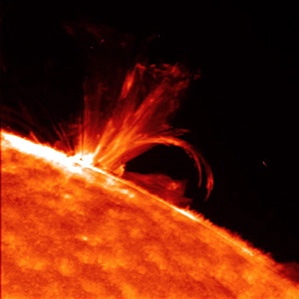NASA's Swift satellite detects monster stellar flare
Scientists using NASA's Swift satellite have
spotted a stellar flare on a nearby star so powerful that, had it been from our
sun, it would have triggered a mass extinction on Earth.

Scientists using NASA's Swift satellite have spotted a stellar flare on a nearby star so powerful that, had it been from our sun, it would have triggered a mass extinction on Earth. The flare was perhaps the most energetic magnetic stellar explosion ever detected. The flare was seen in December 2005 on a star slightly less massive than the sun, in a two-star system called II Pegasi in the constellation Pegasus.
It was about a hundred million times more energetic than the sun's typical solar flare, releasing energy equivalent to about 50 million trillion atomic bombs.
Fortunately, our sun is now a stable star that doesn't produce such powerful flares. And II Pegasi is at a safe distance of about 135 light-years from Earth.
Yet in detecting this brilliant flare, scientists obtained direct observational evidence that stellar flares on other stars involve particle acceleration, just like on our sun. Rachel Osten of University of Maryland and NASA Goddard Space Flight Center in Greenbelt, Md., presents this finding today at the Cool Stars 14 meeting in Pasadena, Calif.
The key finding in the II Pegasi flare was the detection of higher-energy X-rays. Swift's Burst Alert Telescope usually detects gamma-ray bursts, the most powerful explosions known, which arise from star explosions and star mergers. The II Pegasi flare was energetic enough create a false alarm for a burst detection. Scientists quickly knew this was a different kind of event, however, when the flare overwhelmed Swift's X-ray Telescope, a second instrument.
Had the sun flared like II Pegasi, these hard X-rays would have overwhelmed the Earth's protective atmosphere, leading to significant climate change and mass extinction.
And, of course, all the jive discussions about creationism would have come to an abrupt halt. Nature, galactic-scale space, neither pays any attention to insignificant creatures trying to make their existence seem important, the focus of some supernatural critter.
Posted: Tue - November 7, 2006 at 08:09 AM